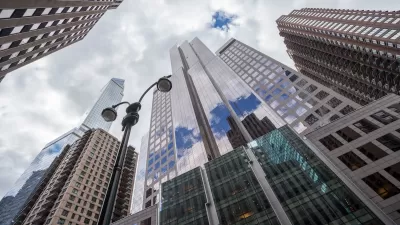When the 807 ft. MetLife Building in Manhattan's Midtown opened half a century ago, it was viewed as an 'assault' on it's iconic neighbor, Grand Central Terminal. However, it was indicative of what the real estate market wanted in the 1960s.
While Grand Central Terminal celebrated it's centennial on Feb. 02 and has received wide attention - with new books, newspaper articles and radio reports, gone relatively unnoticed was the 50-year anniversary of it's massive neighbor - originally known as the Pan Am Building. Ginia Bellafante, who writes the "Big City" column for the New York Times, gives the building's semicentennial the attention it deserves, even if it is not positive.
What is to be marked, really, is a half-century of evinced distaste, though some of it waning under the grip of nostalgia, for a building that existed as an assault on Grand Central Station (sic), its visual foundation bifurcating and marring views of Park Avenue and casting dark shadows on crowded streets beneath it.
Built as the world’s largest corporate structure, with 2.4 million square feet of floor space, the building in its planning phases was known as Grand Central City. The idea was that it would function as a self-sustaining universe — a shopping mall of more than 100,000 square feet. In many ways, the building presaged ...the excesses of the 1980s, both corporate and consumer...
While the Pan Am Building was renamed the MetLife Building in 1981 after it was sold to the Metropolitan Life Insurance Company, "the building was meant to signal the glamorous arrival of the jet age. In 1966, Pan Am began offering rooftop helicopter service to John F. Kennedy International Airport", even if that service only lasted two years.
In contrast to the 1960s, which saw limited public input into planning and resulted in the destruction of New York's original Penn Station and the near-demolition of the now-landmarked 1913 Grand Central Terminal, planning has come full circle as illustrated by the MidTown East plan - "the rezoning of the the area bounded roughly by Fifth and Second Avenues and 39th and 57th Streets". As a result, planning along Park Ave will receive the attention and input from more than just the commercial sector that it received when the initial construction of the Pan Am Building began in 1958.
FULL STORY: BIG CITY: Building High Anxiety

Alabama: Trump Terminates Settlements for Black Communities Harmed By Raw Sewage
Trump deemed the landmark civil rights agreement “illegal DEI and environmental justice policy.”

Planetizen Federal Action Tracker
A weekly monitor of how Trump’s orders and actions are impacting planners and planning in America.

The 120 Year Old Tiny Home Villages That Sheltered San Francisco’s Earthquake Refugees
More than a century ago, San Francisco mobilized to house thousands of residents displaced by the 1906 earthquake. Could their strategy offer a model for the present?

Opinion: California’s SB 79 Would Improve Housing Affordability and Transit Access
A proposed bill would legalize transit-oriented development statewide.

Record Temperatures Prompt Push for Environmental Justice Bills
Nevada legislators are proposing laws that would mandate heat mitigation measures to protect residents from the impacts of extreme heat.

Downtown Pittsburgh Set to Gain 1,300 New Housing Units
Pittsburgh’s office buildings, many of which date back to the early 20th century, are prime candidates for conversion to housing.
Urban Design for Planners 1: Software Tools
This six-course series explores essential urban design concepts using open source software and equips planners with the tools they need to participate fully in the urban design process.
Planning for Universal Design
Learn the tools for implementing Universal Design in planning regulations.
Clanton & Associates, Inc.
Jessamine County Fiscal Court
Institute for Housing and Urban Development Studies (IHS)
City of Grandview
Harvard GSD Executive Education
Toledo-Lucas County Plan Commissions
Salt Lake City
NYU Wagner Graduate School of Public Service



























